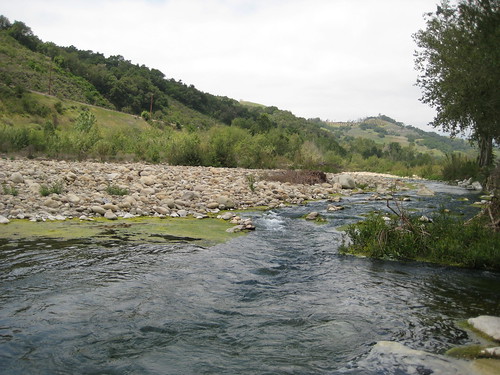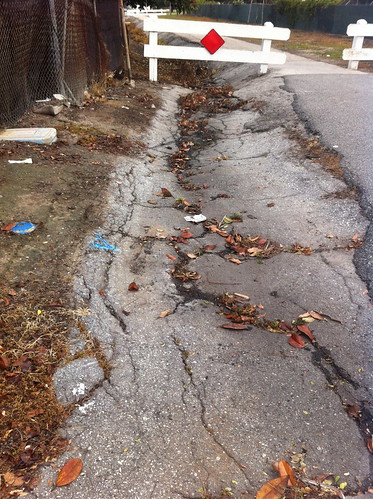This post is part of a series of posts I am creating about finding nature and beauty in the town where I grew up. For more background info, see the first post in the series.
The ability of life to survive and thrive in harsh environments is stunning and incredible. Many offer examples of 'extreme' environments that teem with life, such as deserts and the Arctic. Instead, I offer a place that is in many ways even harsher - and that has given life much less time to adapt to it - and still supports an ecosystem struggling to survive.
View Larger Map
The map above could be a scene from many places in coastal California. The white shrub is almost certainly a flowering coyote brush plant. Around it is a disturbed landscape, but certainly not a heavily-manicured suburban expanse.
Now, please begin zooming out using the map above. As you do so, take note of natural features you see.
Showing posts with label California. Show all posts
Showing posts with label California. Show all posts
Monday, February 13, 2012
Wednesday, February 1, 2012
In The Darkest Places: Life in a Torrance Ditch
For most of the last week, I have been visiting family and friends in Torrance, a suburb of Los Angeles and the place I grew up.
I have a love-hate relationship with California, but my feelings about Torrance have always been more straightforward - there are some people there who are incredibly important to me, but Torrance itself I have always hated.
There isn't much gained in hating a place though, especially one I will end up visiting again, so during this visit I decided to "get curious", as one person has advised me; to try to understand WHY Torrance is how it is, how its past influences it, what wild plants and free water are hiding in the cracks and forgotten places of the present, and what is possible in the future. During my latest trip I found several interesting things, which I'll be writing about in a mini-series of blog posts called "In The Darkest Places"
Sunday, December 19, 2010
Flooding in Southern California
A series of very powerful and wet storms are moving into southern California. These storms are similar to the storms that hit the area in January, 2005, when I lived in Malibu and was dodging mudslides for a couple of months.
The storms will probably cause flooding, especially on Wednesday. If you live in southern California, make sure to stay safe and don't drive across any flooded roadways! It seems like every time there is flooding in that part of the world someone tries to drive across a flooded roadway and is swept away.
It will be interesting to see how some of the new rain gardens and bioswales deal with all this water.
In the long term, the rain will be a good thing. In addition to bringing up a lot of flowers this spring, some parts of the Sierras may pick up to 15 FEET OF SNOW! This snow will be a huge addition to the snowpack, and for once, California may not be short on water this year.
The storms will probably cause flooding, especially on Wednesday. If you live in southern California, make sure to stay safe and don't drive across any flooded roadways! It seems like every time there is flooding in that part of the world someone tries to drive across a flooded roadway and is swept away.
It will be interesting to see how some of the new rain gardens and bioswales deal with all this water.
In the long term, the rain will be a good thing. In addition to bringing up a lot of flowers this spring, some parts of the Sierras may pick up to 15 FEET OF SNOW! This snow will be a huge addition to the snowpack, and for once, California may not be short on water this year.
Tuesday, November 23, 2010
Saving California
California has had quite a bit of trouble lately, and there is a lot of attention being drawn to the economic/housing crisis. This crisis is a big deal, don't get me wrong. We need to fix it. Lurking beneath it, though, is something a lot more sinister. Although it bubbles to the surface from time to time, it really isn't in the public consciousness. Yet, it has the potential to possibly drive California into famine and war that has not been seen in the United States since the days of the Civil War. Do you think I am being overdramatic? Well, I hope I'm wrong, too.
Humans are adaptable, smart, tough, and stubborn. As a species, as a culture, we can get through a lot of incredibly harsh times. The bottom line is, though, that we can not, and will not, survive without enough water.

Disclaimer 1: These views reflect my views only and are not associated with my project in Pittsburgh or anything happening in Vermont.
Disclaimer 2: A lot of what I am going to say here seems impossible, from a political standpoint. It probably is impossible, without major cultural and social changes. It would be hard... but not as hard as going without food and water.
Disclaimer 3: This is really long. I should be working on grad school work, so I should not have just typed this all out.
Humans are adaptable, smart, tough, and stubborn. As a species, as a culture, we can get through a lot of incredibly harsh times. The bottom line is, though, that we can not, and will not, survive without enough water.

Disclaimer 1: These views reflect my views only and are not associated with my project in Pittsburgh or anything happening in Vermont.
Disclaimer 2: A lot of what I am going to say here seems impossible, from a political standpoint. It probably is impossible, without major cultural and social changes. It would be hard... but not as hard as going without food and water.
Disclaimer 3: This is really long. I should be working on grad school work, so I should not have just typed this all out.
Thursday, October 21, 2010
More about Beavers in Southern California
Beavers have been on my mind lately, as evidenced in the long post I made about them yesterday. As mentioned in that post, beavers have huge positive effects on watersheds, and their removal has caused drastic effects that we can't even understand the full effects of. I have wondered if beavers were present in some of the more protected perennial streams (or streams that would be perennial with beaver meadows) of southern California. In fact, today I found evidence that in fact beavers did inhabit at least one more wild southern California stream.
Wednesday, October 6, 2010
It's the First Day of Spring in Los Angeles
It sounds absurd to say, but in effect it is true, if you define spring as the season of growth and renewal. The first rains of the cold season have arrived in southern California. Click below to read more about the turn of the seasons in the place I lived before I moved to Vermont.
Subscribe to:
Posts (Atom)

